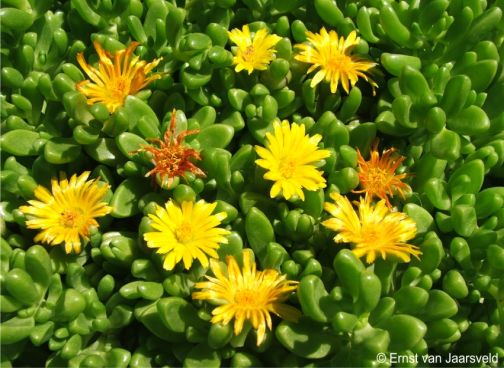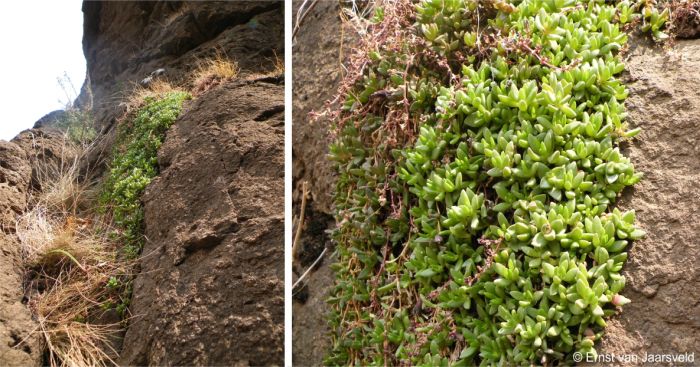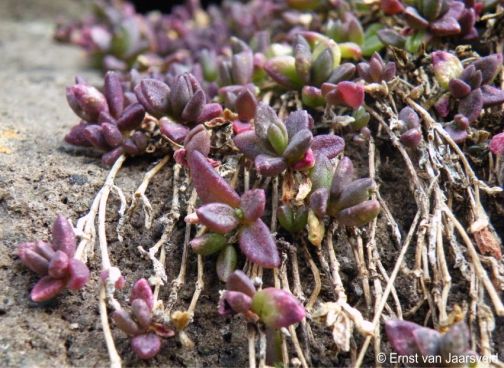Delosperma nubigenum
Delosperma nubigenum (Schltr.) L.Bolus
Family: Aizoaceae
Common names: cloud-born delosperma (Eng.), geel-kransvygie (Afr.); mabone, motabo (Sesotho)
Introduction
The cloud-born delosperma is a mat-forming leaf succulent which becomes pendent on cliffs. It is endemic to the Drakensberg and highlands of Lesotho where it grows on basalt cliffs in deep kloofs. The green leaves almost boat-shaped and the flowers are bright yellow during late spring and summer. It is pollinated by insects. Easily propagated by cuttings and best for alpine grassland gardens, planted on embankments.

Fig. 1. Delosperma nubigenum in flower in the Denver Botanic Gardens, Colorado, USA.
Description
Description
Plants branched, soft, fragile, procumbent shrublets forming dense mats and drooping from cliffs, with stems up to 700 mm long. Roots fibrous. Branches minutely papillate, soft and green at first, rounded in cross-section (terete), often rooting at the nodes. Leaves ascending flattened and oval, in opposite pairs (decussate), dorsiventrally flattened, 12–14 × 5–6 mm, pale to bright green, turning purplish during the dry season; surface minutely papillate, abaxial surface convex; apex acute, apiculate. Flowers terminal, solitary, 20–25 mm in diameter, shortly pedicellate. Petals bright yellow, linear-lanceolate, 10 to 20 mm long, with up to 70 thread-like filamentous staminodes; receptacle top-shaped. Capsule top-shaped. Flowering time is in summer.

Fig. 2. Delosperma nubigenum in fruit in the Denver Botanic Gardens, Colorado, USA.
Conservation Status
Status
Due to its very difficult to reach habitat, the plant is not threatened and consequently it is assessed as Least Concern (LC) in the Red List of South African plants.

Fig. 3. Near the Maletsunyane Waterfall, Semongkong, Lesotho, 19 September 2010, the sheer cliffs are the habitat of Delosperma nubigenum.
Distribution and habitat
Distribution description
Delosperma nubigenum occurs on the escarpment edge of the Eastern Cape, Free State and in Lesotho at altitudes of between 2 500–3 400 m. Often confined to deep gorges and cliffs on all aspects. It is usually associated with sheer basalt cliffs. Plants are rooted in crevices and on ledges, in shallow soil on bedrock, drooping over the rock faces. The associated vegetation consists of Drakensberg Afroalpine Heathland of the Grassland Biome (Mucina et al. 2006).
Temperature is very low in winter, and often with snow. An average daily maximum of 18°C has been recorded. The average daily minimum temperature for the region is 5°C. Rainfall occurs from in summer, 1 000–1 500 mm per annum and the habitat is often covered by fog and cloud. Associated cliff-dwelling plants observed at the Maletsunyane Waterfall, Semongkong in Lesotho include many species of moss and lichen, also Aristaloe aristata, Artemisia afra, Cotyledon orbiculata, Delosperma sp., Crassula nudicaulis, Crassula lanceolata, Crassula setulosa var. rubra, Felicia sp., Cyrtanthus flanaganii, Albuca fastigiata, Stachys sp., Urtica dioica and the shrub Leucosidea sericea.

Fig. 4. The cliffs at the Maletsunyane Waterfall and Delosperma nubigenum in habitat at the Maletsunyane Waterfall and Delosperma nubigenum in habitat on the sheer cliffs, with Cyrtanthus flanaganii growing above it.
Derivation of name and historical aspects
History
The genus name Delosperma is derived from Greek, delos, meaning ‘visible’, and sperma, meaning ‘seed’, pertaining to the capsules of which the seeds are not covered by loculi roofs (Clark & Charters 2016). The species name name nubigenum is Latin and means ‘cloud born’ and pertains to its high altitude habitat that is often covered in cloud. Delosperma nubigenum was discovered by Hans Thode (1859-1923), German naturalist who collected his plant on Mont-aux-Sources in February 1893 which he approached from the Free State side. It was named by Friedrich Richard Rudolph Schlechter (1872-1925) in 1898 in the Journal of Botany as Mesembryanthemum nubigenum. The plant was then transferred to the genus Delosperma by Louisa Bolus in 1960 in Jacobsen’s Handbook of Succulent Plants. Hans Thode came to South Africa in 1886 but he became interested in the Drakensberg flora which he realised (at the time) was unexplored. He remained in Drakensberg region between 1890-1894 where his collections and observations laid a foundation for future studies. He was the first botanist to describe the Drakensberg Mountain flora and was thus a competent plant geographer (Glen & Germishuizen 2010). Thode discovered many species new to science, one of which Schlechter also named Disa thodei in his honour.
Due to its inaccessible high altitude cliff habitat this plant is not regularly collected and thus poorly represented in herbaria.
It is related to Delosperma obtusum which has mauve flowers and larger leaves.

Fig. 5. Delosperma nubigenum in habitat at the Maletsunyane Waterfall.
Ecology
Ecology
Plants forming mats on shallow bedrock, with stems becoming pendent, drooping over the cliff face. A fairly long-lived and fast-growing, cold-tolerant succulent. The ascending green leaves store sufficient amounts of moisture for the dry cold winter months.
The soft, fragile nature of the leaves suggests it has adapted to a safe environment free from the disturbance of larger herbivores, in contrast to the grazed grassland.
The bright yellow, simple flowers are very conspicuous, maximising visibility for successful pollination on the cliff and ledge environment. It is mainly pollinated by bees and small beetles. Flowering time occurs in summer and autumn, this long persistent flowering ensuring an efficient seed supply.
The locules of the 5-locular fruiting capsules are not covered by membranes (as found in many other mesembs), and consequently the seeds are washed out by falling rain drops, and thus locally dispersed by water termed wash-out dispersal, (Hartmann 1991), ideal for establishment in crevices.
Plants increase vegetatively, forming small mats that become pendent, the branches rooting where they touch the soil (vegetative growth), an efficient vegetative dispersal backup and adaptation to the cliff face, ensuring long-term survival. The numerous moss and algae associated with its habitat during the rainy season reflects the high rainfall and moist air and fog. However the winters are dry and sunny when the leaves turn purplish due to the pigment betanin which reduced the process of photosynthesis.

Fig. 6. During the dry season the leaves of Delosperma nubigenum can turn purplish due to the pigment betanin.
Uses
Use
Due to its cold tolerance it became popular as a ground cover in rock gardens in the colder parts of the USA and Europe. In South Africa plants will not flower in a warm frost free climate especially in coastal regions. Plants have been grown at Kirstenbosch National Botanical Garden but refuse to flower due to the mild winters. Therefore when grown in southern Africa it is best grown at altitudes of above 1 500 m. No medicinal or other uses have been recorded.

Fig. 7. Delosperma nubigenum in habitat at the Maletsunyane Waterfall.
Growing Delosperma nubigenum
Grow
Delosperma nubigenum is a very popular succulent ornamental, ground cover in Europe and the colder parts of the USA. In Colorado it is extensively grown as a groundcover. Propagation is both by cuttings or seed.
In South Africa it is best grown on rockeries in higher altitude, cold grassland gardens. (Van Jaarsveld 2010). Although the plant is easily propagated, it should be grown in areas away from aggressively growing species which would outcompete the plant. Delosperma nubigenum grows well in containers in full sun or dappled shade. Re-pot every second year. Refresh from cuttings when the plant becomes untidy.
Grow as a ground cover on steep embankments or rockeries, preferably in full sun. Best established during spring with the onset of spring rains. Fast growing, it should flower during the first season.
Propagate from stem cuttings taken in spring or summer, planted in a sandy soil mixture. Cuttings of about 5–12 cm length can be planted; remove the lower leaves and plant the stems to a depth of about 1–2 cm. Keep moist until well rooted. Rooting will take place within 3 weeks.
Plants grow well in a general succulent mixture, such as 2 parts sand, 1 part garden loam and 1 part peat or well broken down compost but good drainage is essential.
Sow seed during spring in shallow trays in a sandy soil. Cover the seed with a thin layer of sand (1-2 mm) and keep moist.
References
- Bolus, L. 1960. In H. Jacobsen. A handbook of succulent plants: descriptions, synonyms, and cultural details for succulents other than Cactaceae. Blandford Press, London.
- Clarke, H. & Charters, M. 2016. The illustrated dictionary of southern African plant names. Flora & Fauna Publications Trust, Jacana, Johannesburg.
- Glen, H.F. & Germishuizen, G. (compilers). 2010. Botanical exploration of southern Africa, edition 2. Strelitzia 26. South African National Biodiversity Institute, Pretoria.
- Hartmann, H.E.K. 1991. Mesembryanthema. In Systematics, Biology and Evolution of Some South African taxa. Contributions from the Bolus Herbarium 13. 75-157.
- Hartmann, H.E.K. 2001. Aizoaceae F-Z. In Eggli, U. & Hartmann, H.E.K. (eds.). Handbook of Succulent Plants. Springer. Heidelberg, New York, etc.
- Mucina, L. & Rutherford, M.C. (eds) 2006. The vegetation of South Africa, Lesotho and Swaziland. Strelitzia 19. South African National Biodiversity Institute, Pretoria.
- Pooley, E. 2003. Mountain flowers, a field guide to the flora of the Drakensberg and Lesotho. Natal Flora Publications Trust, Durban.
- Raimondo, D., Von Staden, L., Foden, W., Victor, J.E., Helme, N.A., Turner, R.C., Kamundi, D.A. & Manyama, P.A. (eds) 2009. Red list of South African plants. Strelitzia 25. South African National Biodiversity Institute, Pretoria.
- Schlechter, R. 1898. Decades plantarum novarum austro-africanarum. Decas VIII. Journal of Botany, British and Foreign 36:314-318.
- Van Jaarsveld, E.J. 2010. Waterwise gardening in South Africa and Namibia. Struik, Cape Town.
Credits
Ernst van Jaarsveld
Kirstenbosch National Botanical Garden (Retired)
Babylonstoren Farm (Current)
Extraordinary senior lecturer and researcher,
Department of Biodiversity and Conservation, University of the Western Cape
April 2024
Plant Attributes:
Plant Type: Succulent
SA Distribution: Eastern Cape, Free State
Soil type: Loam
Flowering season: Early Summer, Late Summer
PH: Neutral
Flower colour: Yellow
Aspect: Full Sun, Morning Sun (Semi Shade), Afternoon Sun (Semi Shade)
Gardening skill: Easy
Special Features:
Horticultural zones







Rate this article
Article well written and informative
Rate this plant
Is this an interesting plant?
Login to add your Comment
Back to topNot registered yet? Click here to register.